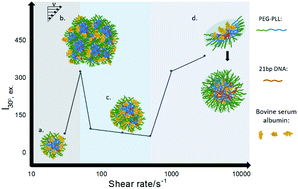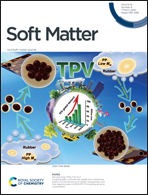PEGylated gene carriers in serum under shear flow†
Abstract
The behaviour of drug/gene carriers in the blood stream under shear is still a puzzle. In this work, using the complexes formed by 21 bp DNA and poly(ethylene glycol)-b-poly(L-lysine) (PEG–PLL) of varying PEG lengths, we studied the dynamic behaviour of the complexes in the presence of fetal bovine serum (FBS) and under flow at different shear rates, a condition mimicking the internal physical environment of blood vessels. The PEG5k-PLL/DNA complex possesses a dense DNA/PLL core and a loose PEG5k protecting layer. The PEGylated DNA complexes exhibit multiple responses to external shear in the presence of FBS. The loose PEG5k layer is firstly disturbed at a shear rate below 30 s−1. The exposure of the charged core to the environment results in a secondary aggregation of the complex with FBS. The size of the aggregate is limited to a certain range as the shear rate increases to 50 s−1. The dense DNA/PLL core starts to withstand the shear force as the shear rate reaches 500 s−1. The reorganization of the core to accommodate more serum molecules leads to tertiary aggregation of the complexes. If PEG cannot form a valid layer around the complex, as in PEG2k-PLL/DNA, the complex forms an aggregate even without shear, and the first shear dependent region is missing. If the PEG layer is too stable around the complex, as in PEG10k-PLL/DNA, no tertiary aggregation occurs. The mechanism of shear on the behaviour of delivery particles in serum helps to design gene carriers with high efficacy.



 Please wait while we load your content...
Please wait while we load your content...